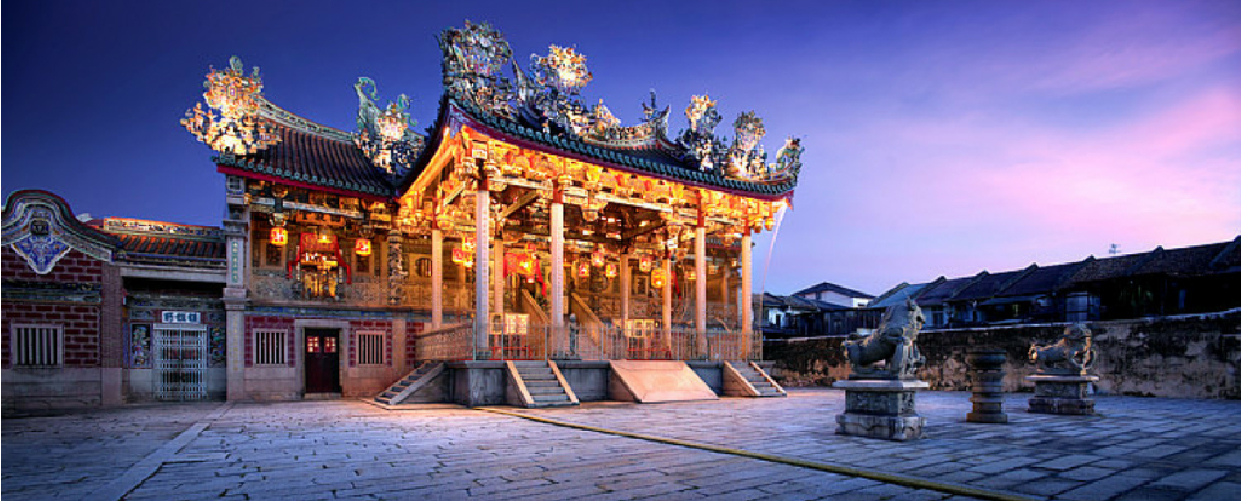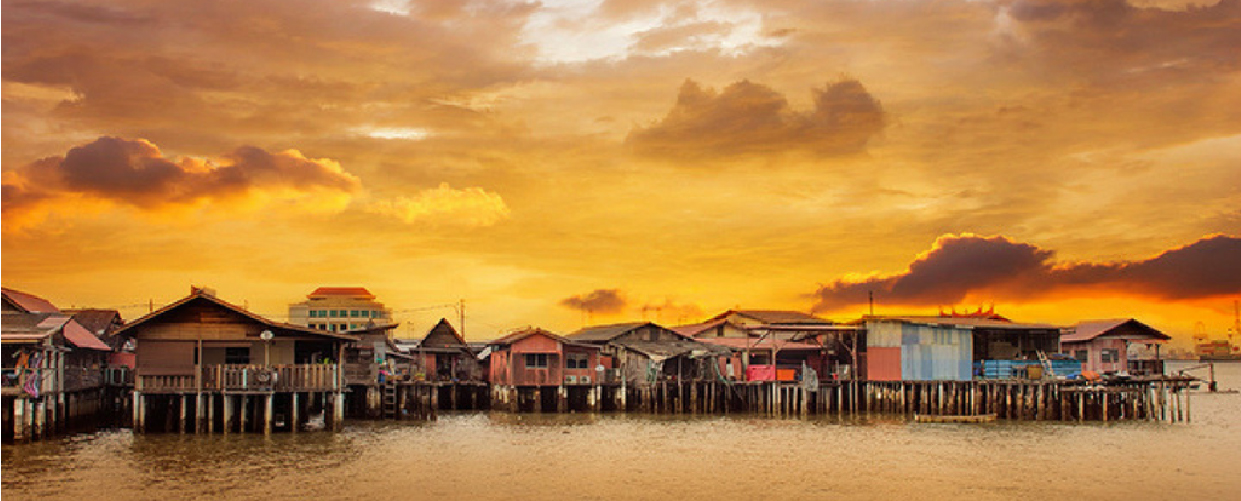
Not only food, architectural monuments are also a unique cultural scene in Penang. As a world cultural heritage, Penang can be seen everywhere with various historical buildings. Through different shapes and decorations, you can understand and penetrate the culture, history and stories.
The following are the top 10 historical monuments compiled by the editor. If you are a friend who is traveling to Penang for the first time, you may wish to include it in your must-see list:
1. Fort Cornwallis
Picture taken from penangbyhotels.com
Fort Cornwallis, located in the northeast of George Town, Penang, was built in 1786. It was originally the place where Captain Wright landed, and was later built by the East India Company as a defense against enemy aggression. The castle was originally made of wood, but later the British colonial government used prisoners to convert it into a stone castle.
To this day, you can still see chapels, cells, ammunition depots, cannons and other facilities built in the previous century in the city protection. According to legend, this Dutch cannon is good for reproduction, so many women offered flowers in the cannon barrel to pray for a child.
The picture is taken from thelongestway
2. Queen Victoria Memorial Clock Tower
Picture taken from penangbyhotels.com
The Old Gurney Drive Clock Tower, located near Cornwallis Castle, is one of the most famous landmarks in Penang. The centuries-old bell tower is a mixture of British architecture and Moorish domes. It was built by Xie Zengyu, a wealthy local Chinese businessman, and used to commemorate the 60th anniversary of Queen Victoria's ascension to the throne.
Later, the Municipal Council added neon lights and giant iron betel nuts to the clock tower to show its modernity. Although the bell tower is no longer in use, its historical value and commemorative significance are indeed memorable.
Picture taken from pinterest
3. Penang City Hall & Town Hall
Picture taken from wikipedia
The Penang City Hall and the Parliament Building, which are also located near the Cornwallis Castle, are the eye-catching European-style architectural landscapes in the old Gurney Drive. The Town Hall on the left near Wright Street was built in 1880. It was originally established not only as a performing arts and meeting place, but also as an affirmation of the status of the local government in the colonial era. The local Chinese even call it Hongmao Mansion. The City Hall on the other side of the sea is the new building of the City Council, which was completed in 1903.
Picture taken from lexissuitepenang
4. Khoo Kongsi
Picture taken from khookongsi
Penang Lung San Tang Khoo Company is hidden in Dajuan Street, George Town. It is the oldest family temple in Penang and the largest Chinese guild hall in Malaysia. The ancestral hall is very grand and magnificent, exquisitely carved, and built after the design of Qing Dynasty palaces.
It is reported that the Qiu clan is one of the "five surnames" of the Hokkien people in Penang. Since the middle of the 19th century, each surname has established its own company, street house and ancestral hall as the center. Although it has been more than a hundred years old, the overall layout of the ancestral hall, nearby buildings, grand stage, and row houses are all preserved intact. It is a historical building that witnesses the local Chinese.
Picture taken from jomjalan.com
Picture taken from penangbyhotels.com
5. Wat Chayamangkalaram Thai Buddhist Temple
Picture taken from trekearth
Built in the 19th century, the Temple of the Reclining Buddha, also known as the Thai Buddha Temple, is one of the best Thai Buddhist temples in Penang. In order to promote friendly relations with Thailand at that time, the British colonial government allowed Thais living in Penang to build this Thai temple.
When you enter, you can not only see the incisive and brilliant exterior decoration, but also the golden pagoda behind the main hall. Inside the hall is enshrined a 33-meter-long reclining Buddha, the third largest in Southeast Asia. The whole body is decorated with gold leaf, and the eyes and nails are inlaid with shells, which is very special. Behind the reclining Buddha is the place where believers deposit ashes. In addition, there are statues of the Eighteen Arhats and other gods for people to worship.
Figure taken from commonswikipedia
6. Kek Lok Si Temple
Picture taken from tourismmalaysia
Kek Lok Si Temple is the largest and most famous Buddhist temple in Southeast Asia. Founded in 1893 and located in Air Itam, Heshan in the area has always been regarded as a geomantic treasure and a good location for building temples.
The main attraction of Kek Lok Si Temple is the seven-story Rama Pagoda, also known as the Buddha Pagoda, which is about 30 meters high. The body of the pagoda is plain white, with a Chinese octagonal base at the bottom; the body of the pagoda is Thai style with a Burmese crown. There are also a large number of alabaster and bronze Buddha statues enshrined in the temple. You can also climb or take the cable car to the top of the tower to visit the 30.2-meter-high bronze statue of Guanyin and enjoy the scenery of Penang. In addition, it coincides with the Chinese Lunar New Year, and the temple will be decorated with lanterns and festoons, which is another new scene.
Picture taken from trekearth
Picture taken from makemytrip
Image taken from penang.attractionsinmalaysia
7. Syed Alatas Mansion
Figure taken from commonswikipedia
This 4-walled, self-contained open-air garden and detached house is the former residence of Syalatas. After being officially taken over by the Malay Chamber of Commerce in 2003, it officially became an Islamic museum.
It is reported that Sai Alatas is an Aceh spice merchant with two wives. His first wife is a Malay royal family, and his second wife is the daughter of pepper merchant Qiu Tianbao. In the 1870s, Sai Alatas was keen on Aceh's war against the Netherlands. In addition to providing arms, he also lent his residence as a secret meeting place for Aceh leaders from time to time.
Picture taken from malaymail
8. St. George’s Anglican Church
Picture taken from penangbyhotels.com
St. George's Church, located on Huagai Street in George Town, is the oldest Anglican church in Penang. At that time, it was founded by a group of British missionaries who were preaching locally and was completed in 1818. The church is white in appearance, with towering spires and a green lawn in front of it. It has a British style and is one of the most representative buildings of the British style.
In addition, the church also has a small pavilion to commemorate Captain Wright. Later, St. George's Church was listed as one of the top 50 national treasures by the Malaysian government and underwent large-scale restoration.
Picture taken from justgola
The picture is taken from tripadvisor
9. Clan Jetties Of Penang
Picture taken from hoteljen
Surname Bridge is the earliest Chinese floating village in Georgetown, Penang. Located in the area of Haiqu Street, you can see houses on the water clustered by surnames, such as Linqiao, Zhouqiao, Chenqiao, and Liqiao. Among them, the surname Zhouqiao is the largest, with about 60 households in the water. The houses are built on the sea and supported by wooden piles, and the streets in the village are bridges paved with wooden boards, forming a unique kampong style.
Dating back to the end of the 19th century, when the Chinese went south to settle in Penang and chose to make a living by fishing. As the number of people grew, they simply built bridges and built houses in the port, forming today's water villages with surnames.
Picture taken from malaysiamall
The picture is taken from timeout
10. Sri Mahamariamman Temple, Penang
Dibina pada tahun 1833, Kuil Mahamarian dikenali sebagai kuil India tertua di Pulau Pinang. Di dalam kuil terdapat patung-patung Subramaniam yang tidak ternilai, semuanya dihiasi dengan emas, perak, berlian dan zamrud. Khabarnya apabila agama Hindu mula diperkenalkan ke negara saya pada awal abad ke-7, dewi Mariamman merupakan tuhan yang paling disembah oleh orang India ketika itu, kerana mereka percaya bahawa dewi itu dapat melindungi mereka daripada penyakit.
The most eye-catching thing is the tower at the entrance, which depicts all kinds of characters in vivid shapes and rich colors. Believers firmly believe that there will be a deity coming to the temple every Jiazi, so the statue must be replaced every Jiazi to welcome the new god.
Image taken from spiceandcurry and traveltomalaysia
The picture comes from the Internet, if there is any infringement, please inform.
post a comment
You must be logged in to post a comment.


